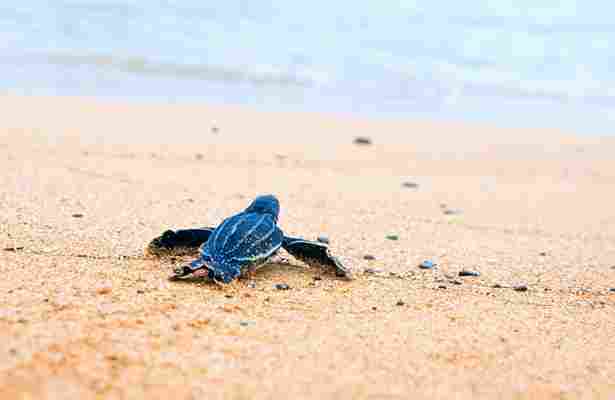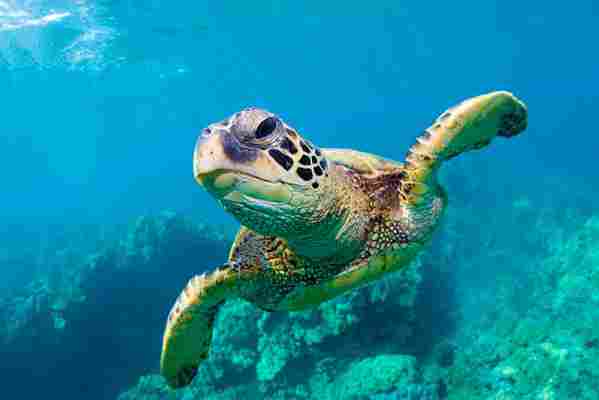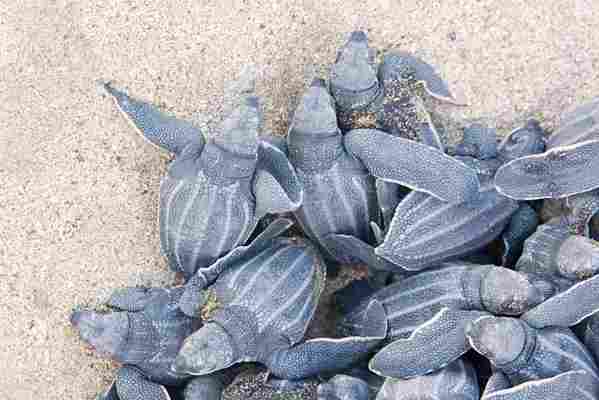
During a normal spring nesting season, sea turtles around the world face a number of obstacles, from crowded beaches and distracting lights to busy waterways and polluted habitats. But with the pandemic keeping people away, the marine reptiles are flourishing.
In Florida, the beaches are just starting to reopen to the public, but while they’ve been closed, loggerheads and leatherbacks have been nesting in record numbers. At Juno Beach, one of the world’s most densely nested sea turtle beaches in the world, the Loggerhead MarineLife Center had found 101 leatherback nests and at least three loggerhead nests as of last week, the organization said.

"Our leatherbacks are coming in strong this year. It's going to be a really good year,” Sarah Hirsch, senior manager of research and data at Loggerhead Marinelife Center, told West Palm Beach’s CBS12 News . “Our world has changed, but these turtles have been doing this for millions of years and it’s just reassuring and gives us hope that the world is still going on."
In Thailand, where the border has been closed to foreigners since late March and a curfew has been effect since early April, vulnerable leatherbacks are also thriving. Reuters reports that authorities have found 11 turtle nests since last November – the highest number in 20 years. “This is a very good sign for us because many areas for spawning have been destroyed by humans,” Phuket Marine Biological Center director Kongkiat Kittiwatanawong told the wire service. “If we compare to the year before, we didn’t have this many spawn, because turtles have a high risk of getting killed by fishing gear and humans disturbing the beach.”

The Brazilian town of Paulista plays host to four types of turtle, loggerheads, green sea turtles, olive ridley turtles, and hawksbills, and it’s seen more than 300 hatch this year, the Guardian reported in late March. Known for their pointed beaks and their classic tortoiseshell-patterned shells, hawksbills are classified as critically endangered by the World Wildlife Fund – and earlier in the season, nearly 100 of them hatched in Paulista in a single day, according to the Guardian.
“It’s really beautiful because you can see the exact instant they come out of the eggs and … watch their little march across the beach,” Paulista environmental secretary Roberto Couto told the paper. “This time, because of coronavirus, we couldn’t even tell people it was happening.”
On April 11, Padre Island National Seashore’s Division of Sea Turtle Science and Recovery announced the discovery of the first Kemp’s ridley sea turtle nest in Texas, and the following week, the Sea Turtle Conservancy in Tortuguero, Costa Rica, reported 45 leatherback nests, three green sea turtle nests, and one hawksbill nest.
"All of the potential positive impacts relate to changes in human behavior," David Godfrey, executive director of the Sea Turtle Conservancy, told CBS News . “The chances that turtles are going to be inadvertently struck and killed will be lower,” he said, thanks to the worldwide decreases in cruise-ship traffic and pleasure boating, and “the reduced human presence on the beach also means that there will be less garbage and other plastics entering the marine environment.”
The noticeably darker beaches should also prove to be a boon, Godfrey said; "we expect that thousands of hatchlings that ordinarily would be disoriented by lights this nesting season will not be – and are more likely to survive to reach the sea."
The coronavirus (COVID-19) is now a global pandemic. Find out what this means for travelers .
Read more: These lions are enjoying the absence of visitors in Kruger National Park Animals come out to play in Yosemite while humans stay away This US wildlife care center has returned dozens of birds to their natural habitats With crowds away, this Florida conservation group is helping local marine life
